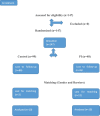Effects of a computerized psychological inoculation intervention on condom use tendencies in sub Saharan and Caucasian students: two feasibility trials
- PMID: 34040845
- PMCID: PMC8114391
- DOI: 10.1080/21642850.2019.1614928
Effects of a computerized psychological inoculation intervention on condom use tendencies in sub Saharan and Caucasian students: two feasibility trials
Abstract
Objective: An effective method for preventing the Human Immunodeficiency Virus (HIV) is condom use. Yet, research shows limited effects of education on increasing condom use. This research examined the effects of psychological inoculation (PI) versus education on condom use -barriers and -tendencies, using a fully automatized online system. Design: Two randomized controlled trials. In Study 1, 59 Sub-Saharan students were included while Study 2 20 European students were included. In both studies, participants were randomly assigned to PI or control conditions. In Study 2, we additionally matched pairs on gender and condom barriers. In the PI, participants received challenging sentences they had to refute. Main outcome measures: An indirect condom use test (I-CUTE) and a condom use barriers questionnaire, assessed at baseline and a month later. Results: In Study 1, a significant increase in I-CUTE scores and no change in barriers was found in the PI condition. Controls did not change on either outcome. In Study 2, two sub-scales of condom barriers (concerning partner and satisfaction) were significantly decreased in the PI group, while in controls, barriers significantly increased over time. In both groups, I-CUTE scores tended to increase. Conclusions: These results replicate previous studies and extend them to a fully automatized system without counselors.
Keywords: Condom use; HIV; automatized system; barriers; psychological inoculation; sub-Sahara Africa.
© 2019 The Author(s). Published by Informa UK Limited, trading as Taylor & Francis Group.
Conflict of interest statement
No potential conflict of interest was reported by the authors.
Figures
Similar articles
-
The effects of psychological inoculation on condom use tendencies and barriers; a randomized controlled trial.Psychol Health. 2021 May;36(5):575-592. doi: 10.1080/08870446.2020.1775832. Epub 2020 Jun 5. Psychol Health. 2021. PMID: 32498613 Clinical Trial.
-
A new measurement of an indirect measure of condom use and its relationships with barriers.SAHARA J. 2017 Dec;14(1):24-30. doi: 10.1080/17290376.2017.1375970. SAHARA J. 2017. PMID: 28903643 Free PMC article.
-
[Current status of the female condom in Africa].Sante. 1997 Nov-Dec;7(6):405-15. Sante. 1997. PMID: 9503499 Review. French.
-
Effects of Psychological Inoculation Versus Health Education on Physical Activity: Two Randomized Controlled Studies.J Phys Act Health. 2018 Apr 1;15(4):295-302. doi: 10.1123/jpah.2017-0088. Epub 2018 Feb 9. J Phys Act Health. 2018. PMID: 29421967 Clinical Trial.
-
How can psychological theory help to promote condom use in sub-Saharan African developing countries?J R Soc Health. 1997 Jun;117(3):186-91. doi: 10.1177/146642409711700311. J R Soc Health. 1997. PMID: 9195835 Review.
References
-
- Adih, W. K., & Alexander, C. S. (1999). Determinants of condom use to prevent HIV infection among youth in Ghana. Journal of Adolescent Health, 24(1), 63–72. - PubMed
-
- Ajzen, I. (1991). The theory of planned behavior. Organizational Behavior and Human Decision Processes, 50, 179–211.
-
- Asare, M., Sharma, M., Bernard, A. L., Rojas-Guyler, L., & Wang, L. L. (2013). Using the health belief model to determine safer sexual behavior among African immigrants. Journal of Health Care for the Poor and Underserved, 24(1), 120–134. - PubMed
LinkOut - more resources
Full Text Sources
Research Materials
Miscellaneous


